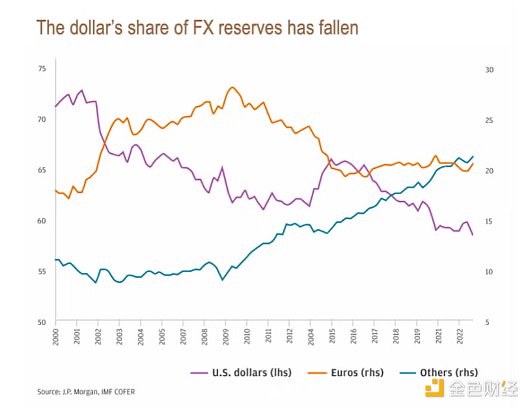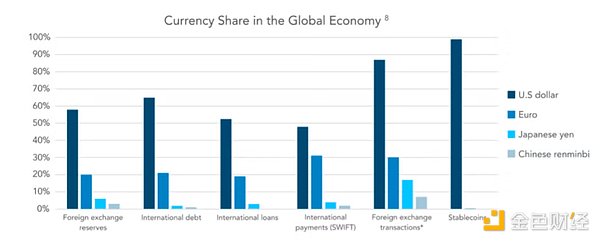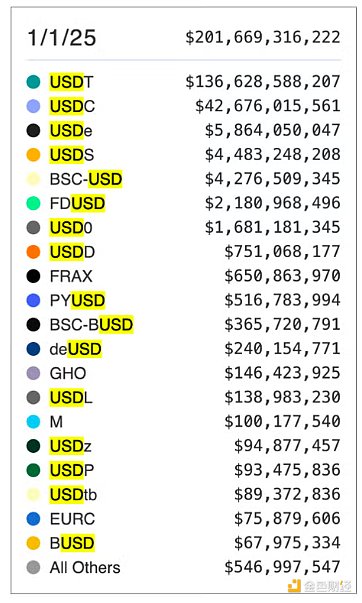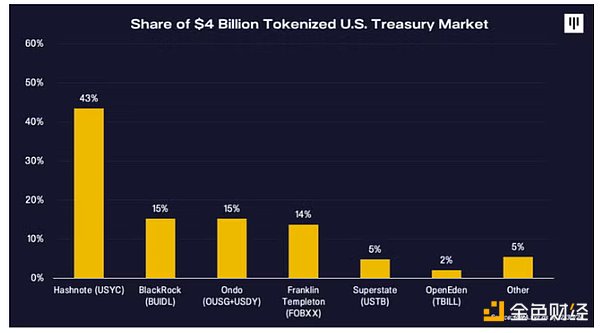Author: Jeff Lewis, Hedge Fund Product Manager at Pantera Capital; Erik Lowe, Content Director at Pantera Capital; Translated by: 0xjs@Golden Finance
The growing trend of de-dollarization, where countries and institutions no longer rely on the U.S. dollar for global trade and financial transactions, has raised concerns about the long-term dominance of the U.S. dollar.
The most common measure of the dollar's dominance - the share of foreign exchange reserves held by the dollar - has been on a long-term downward trend, falling 13 percentage points since 2000.
 We believe that this trend is about to reverse, and ironically, it is driven by the factors that most U.S. policymakers and central bankers believed five years ago were accelerators of the dollar's devaluation: blockchain technology and tokenization. What was once seen as a potential destroyer of the dollar's status is now becoming the biggest promoter of its status.
We believe that this trend is about to reverse, and ironically, it is driven by the factors that most U.S. policymakers and central bankers believed five years ago were accelerators of the dollar's devaluation: blockchain technology and tokenization. What was once seen as a potential destroyer of the dollar's status is now becoming the biggest promoter of its status.
"The most ironic outcome is the most likely to happen." - Elon Musk
Super Dollar
The public chain enhances the circulation of legal tender, making it easy for 5 billion smartphone users around the world to use legal tender and enabling it to flow across borders easily. The demand for tokenized legal tender (i.e. stablecoins) has created a massive industry worth $200 billion, with the dollar dominating. Castle Island and Brevan Howard released a report that includes the following chart showing the near 100% dominance of USD collateral in stablecoins relative to other economic categories.

Source: Castle Island and Brevan Howard Report
Of the top 20 fiat-backed stablecoins, 16 have "USD" in their names.

Source: rwa.xyz
Sixteen years after the birth of blockchain, the general view of it has hardly changed. Bitcoin's original advocates did see the potential for the cryptocurrency to challenge the dominance of the US dollar. In recent years, Bitcoin has been increasingly viewed as a tool for storing wealth rather than a medium of exchange, minimizing its threat in this regard. The rise of the stablecoin/RWA phenomenon has enabled blockchain to deliver on Bitcoin's original promise of providing a means of transaction with stability and ultimately yield. Far from weakening the dollar's relevance, it has strengthened it.
Emerging Markets
In emerging markets, dollar-backed stablecoins are a practical alternative to holding physical cash or relying on fragile banking systems. Given a choice, merchants and citizens in countries with unstable currencies will increasingly gravitate toward the stability of a digital dollar. In their report, Castle Island and Brevan Howard published the results of a survey of existing cryptocurrency users in emerging markets. A key conclusion: dollar-denominated savings are a huge driver of emerging markets.
47% of respondents said they use stablecoins primarily for savings in USD (this is slightly lower than the 50% who use stablecoins primarily to trade cryptocurrencies or NFTs)
69% of respondents have exchanged their local currency for stablecoins that are not used for transactions
72% of respondents expect to increase their use of stablecoins in the future
Note: The countries surveyed include Nigeria, Indonesia, Turkey, Brazil, and India
Whether users are small consumers or multinational corporations, the US dollar may crowd out other local currencies as economic entities tend to choose the safest and most liquid currencies.
In America’s Best Interests—Stablecoin Legislation in 2025?
Legislative momentum is building, and the Trump administration is expected to pass stablecoin-focused regulations. Patrick McHenry’s Stablecoin Act has bipartisan support and was originally introduced in 2023 and recently introduced to the House by Rep. Maxine Waters. Stablecoin legislation has long been seen as the first step toward regulatory clarity in the United States. We believe we will see meaningful progress in 2025, especially as policymakers increasingly recognize the strategic role of stablecoins in expanding the influence of the dollar.
Stablecoins are in the best interest of the United States because they will increase the proportion of transactions denominated in dollars and create demand for U.S. Treasury collateral.
A country with $37 trillion in outstanding debt needs to distribute fiat currency, and cryptocurrencies can provide that distribution.
Stablecoins Vs. CBDC
For clarity, fiat-backed stablecoins and central bank digital currencies (CBDCs) are two similar but fundamentally different technologies that should not be conflated.
JPMorgan Chase published a report in October on the growing trend of de-dollarization. One of the potential drivers they highlighted is the push for payment autonomy through new technologies. They mentioned projects such as the multi-central bank digital currency initiative mBridge as a potential alternative to US dollar transactions.
While emerging payment systems such as foreign CBDCs have further exacerbated the pressure of de-dollarization, we believe that the booming market for US dollar-backed stablecoins contradicts this narrative. We believe that stablecoins built on decentralized, permissionless blockchains will be preferred as they provide better privacy, censorship resistance, and cross-platform interoperability.
Meeting the demand for US Treasuries through tokenized products
According to the US Treasury, $120 billion of stablecoin collateral is directly invested in US Treasuries, which has led to an increase in demand for short-term securities. In addition to stablecoins, direct tokenization of US Treasuries is also a growing trend. Companies such as BlackRock’s Securitize, Franklin Templeton, Hashnote and Pantera portfolio company Ondo are in charge of this $4 billion market.

Ondo offers two core products in this space:
USDY (Dollar Yield Token): A tokenized note backed by short-term U.S. Treasuries and bank deposits, providing non-U.S. investors with a stable, high-quality yield.
OUSG (Ondo Short-Term U.S. Government Bond): Provides liquid exposure to short-term U.S. Treasuries, allowing qualified purchasers to mint and redeem them immediately.
Products such as USDY provide easier access to dollars and Treasuries for people living overseas than traditional channels.
A New Era of Dollar Dominance
Far from undermining the dollar’s hegemony, blockchain technology has created the digital infrastructure that underpins it. The ability to tokenize and mobilize dollar assets around the world makes the dollar still indispensable, even as geopolitical and technological forces drive pressure to de-dollarize. As JPMorgan notes in its report, the structural factors that support the dollar’s dominance—deep capital markets, rule of law, and institutional transparency—remain unparalleled. Stablecoins extend these advantages to a digital, borderless environment.
Once seen as the underdog to blockchain innovation, the U.S. dollar is now its biggest beneficiary. Blockchain’s “killer app” may well be the dollar itself, demonstrating how technology can both transform traditional power structures and strengthen them.As supportive regulatory frameworks emerge and demand for tokenized assets grows, the dollar’s migration on-chain could solidify its position as a cornerstone of global finance. Whether U.S. regulators or lawmakers are Democrats or Republicans, they will agree that any force that supports demand for U.S. Treasuries is a force that should be harnessed, not resisted, making meaningful regulatory progress a near fait accompli.
 Alex
Alex
 Alex
Alex Kikyo
Kikyo Brian
Brian Brian
Brian Kikyo
Kikyo Alex
Alex Kikyo
Kikyo Brian
Brian Alex
Alex Alex
Alex